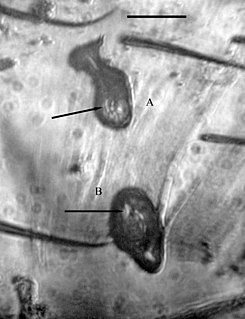Related Research Articles

Eimeria is a genus of apicomplexan parasites that includes various species capable of causing the disease coccidiosis in animals such as cattle, poultry, dogs, cats, and smaller ruminants including sheep and goats. Eimeria species are considered to be monoxenous because the life cycle is completed within a single host, and stenoxenous because they tend to be host specific, although a number of exceptions have been identified. Species of this genus infect a wide variety of hosts. Thirty-one species are known to occur in bats (Chiroptera), two in turtles, and 130 named species infect fish. Two species infect seals. Five species infect llamas and alpacas: E. alpacae, E. ivitaensis, E. lamae, E. macusaniensis, and E. punonensis. A number of species infect rodents, including E. couesii, E. kinsellai, E. palustris, E. ojastii and E. oryzomysi. Others infect poultry, rabbits and cattle. For full species list, see below.

Leucocytozoon is a genus of parasitic alveolates belonging to the phylum Apicomplexa.

Eimeriidae is a family of Apicomplexa. It contains the following genera:
Dactylosoma is a genus of parasitic alveolates of the phylum Apicomplexia.

Vetufebrus is an extinct genus of haemospororida in the family Plasmodiidae. At the time of its description the new genus comprised a single species Vetufebrus ovatus known from a single Miocene Dominican amber fossil found on Hispaniola. V. ovatus was vectored by Enischnomyia stegosoma, the first fossil steblid bat fly described from a fossil, and the only member of the subfamily Nycterophiliinae described from Hispaniola. V. ovatus is the first instance of a Streblidae bat fly as a host for a malarial parasite.
Rhytidocystis is a genus of apicomplexans.

Klossiella is a genus of parasitic alveolates of the phylum Apicomplexa. Species in this genus infect the renal tract of mammals and intestinal tract of snakes.
Nephroisospora is a genus of parasites that infects bats
The Archigregarinorida are an order of parasitic alveolates in the phylum Apicomplexa. Species in this order infect marine invertebrates — usually annelids, ascidians, hemichordates and sipunculids.
Hyaloklossia is a genus of parasitic alveolates in the phylum Apicomplexa. Only one species in this genus is currently recognised - Hyaloklossia lieberkuehni.
Alveocystis is a genus in the phylum Apicomplexa. Species in this genus infect worms of the family Priapuloidea and molluscs. This genus has been poorly studied and little is known about it.
The Syncystidae are a family of parasitic alveolates in the phylum Apicomplexa. Species in this family infect insects (Aeshnidae).
The Schizocystidae are a family of parasitic alveolates in the phylum Apicomplexa. Species in this family infect insects.
Farinocystis is a genus of parasitic alveolates of the phylum Apicomplexa. Species in this genus infect insects (Coleoptera).
Mattesia is a genus of parasitic alveolates of the phylum Apicomplexa. Species in this genus infect insects.
Filipodium is a genus of parasites in the phylum Apicomplexa. Species in this genus infect marine invertebrates.
Syncystis is a genus of parasitic alveolates in the phylum Apicomplexa.
Schizocystidae is a genus of parasitic alveolates in the phylum Apicomplexa.
Menzbieria is a genus of parasitic alveolates of the phylum Apicomplexa.
Lipocystis is a genus of parasitic alveolates of the phylum Apicomplexa.
References
- ↑ Wasielewski T (1904) Studien und Mikrophotogramme zur Kenntnis der Pathogenen Protozoen. Johann Ambrosius Barth, Leipzig
| | This Apicomplexa-related article is a stub. You can help Wikipedia by expanding it. |